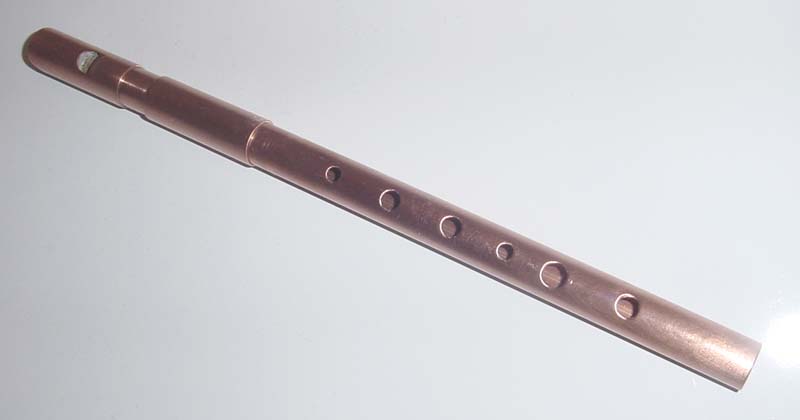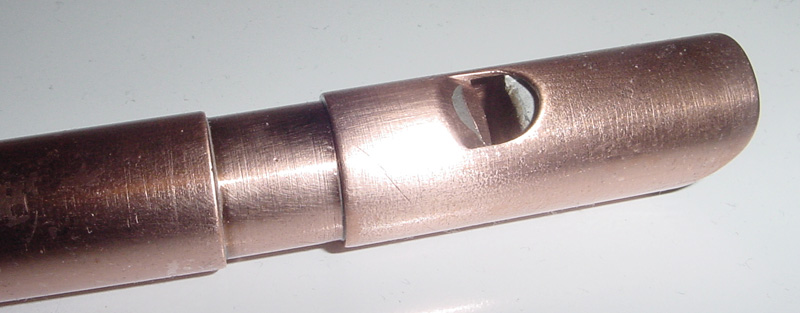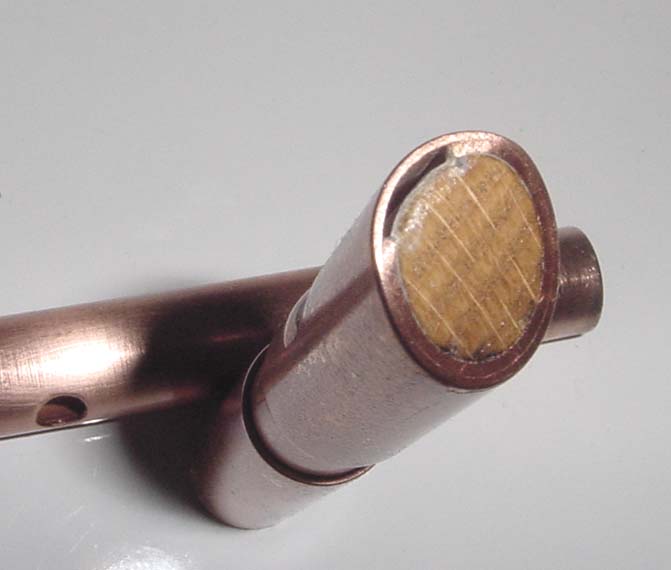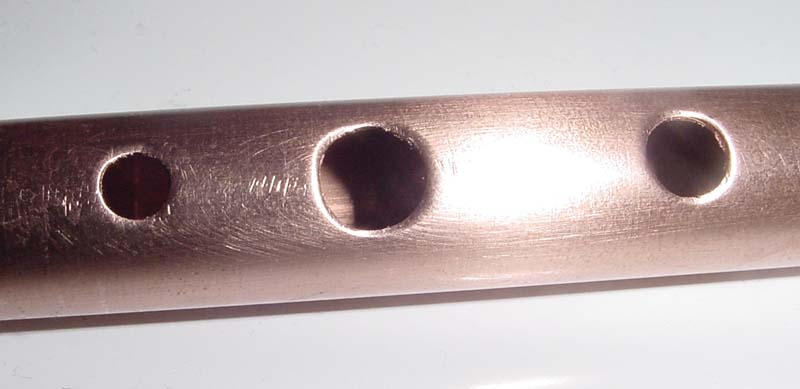Review housed at http://www.tinwhistler.com/reviews.asp
Keltic Dead Soprano D whistle
(Review written December 2005)
Preface
Earlier this year, Shaun-Patrick Young signed up on the Chiff and Fipple message board and expressed his condolances at the passing of Glenn Schultz, maker of thin Weasel whistles. I took note of the fact that he made whistles and that Paul Busman (maker of Busman whistles) spoke highly of them. Later, I made contact, and we talked a bit back and forth in email about me reviewing a whistle, and eventually I caught up with him at a local Sunday session here in the DFW area. I didn’t know he was local to DFW, and he thought I was still in Houston, so we just never hooked up before. He’d brought a whistle for me to check out, and here it is!
At a Glance
Whistle Reviewed: Keltic Dead Soprano D whistle
Models Available: Tunable Soprano D
Construction: Copper with wooden fipple
Price at time of review:$80 US
Available From: the Keltic Dead website
How Acquired: Product sample from manufacturer
Appearance/Construction
The Keltic Dead whistle falls into that growing class of whistles made of copper tubing, alongside McHaffie whistles (no longer in business), O’Brien whistles, and South Wind whistles. I don’t know if Glenn Schultz was the first person to ever make a professional whistle out of PVC..but I do know that since the popularization of Water Weasel whistles, a lot of manufacturers have turned to PVC in their whistle construction. It stands to reason..the tube is already made at the right thickness and diameter, so you can focus your attention on turning it into a whistle. So, it’s no surprise to me to see the same kind of phenomenon happening with copper tubing. And just like there’s only superficial similarities between a Hoover and a Thin Weasel, there are only superficial similarities among these instruments as well. Every make I’ve handled has taken a different direction in whistle design, resulting in a different sound and different playing characteristics.

Here’s the full whistle. It’s still all shiny. This whistle is coated with a spray finish to protect the whistle and prevent tarnish, but this is an experimental procedure. I don’t believe that the regular Keltic Dead whistles get this treatment, but if it intrests you, you might want to ask about it when you order. These pictures are taken after me having the whistle about 3 weeks, and there’s still no sign of tarnish.

Here’s a close-up of the mouthpiece. It was the first thing that really stood out when I picked up this whistle. The labium ramp is shaped a lot like a Reyburn. Visually, you can see three layers of material shaping the ramp, two layers of copper with some expoxy resin in between. But when I run my fingers across them, those layers mesh together smooth as glass. The second thing to notice is the rounded top of the windway exit. I think that’s a fairly unique feature.
You can also see a bit of the tuning slide in this picture. It’s made of a longish sleeve of copper. It allows the whistle to slide smoothly within it, but fits snugly enough to keep the thing from moving around from lip pressure once it’s set.

Here’s another angle on the mouthpiece, showing the oak fipple. The mouthpiece style here is very similar to an Abell, with that same bit of stubbiness. I’m totally used to it, but when I first got my Abell, it was a while before I stopped noticing it.

A shot at the end of the whistle, showing the last three holes.
Playing Characteristics This whistle has a nice complex tone. It has what I would consider to be the perfect amount of start-of-note chiff, crisp and accenting the note nicely without being airy, hissy, or even very noticeable unless you’re listening for it.
Sound clip of the whistle:
Out on the Ocean
Volume: Loud, which is good for outdoor play or at a large session. I was able to play this whistle at the Sunday session, and completely fill up a bar with the sound. Granted, there were only about 10 people in the bar, so there wasn’t much white noise to contend with, but none of those people had any trouble hearing the whistle.
Responsiveness: Quick playing whistle. I was able to pop cuts and crans out of it without any hesitation or mushiness.
Tuning: Probably as a compromise for the even hole positioning, this whistle takes a little big of extra work with your breath control. F# and A have to be pushed a little agressively to bring them in tune with the rest of the whistle. A little extra push on F# (and sometimes A) is not uncommon for many whistles, and this one just takes a little more than usual. The rest of the notes require just a little less air than you’d expect. With that in mind and the alternative C-Natural fingering, this whistle can be played in tune. Copper is used in cookware because it is a superior conductor of heat. That means heat is quickly and evenly transfered to the entire pan, without causing hotspots. Even compared to aluminum, copper conducts heat extremely swiftly. For that reason, copper whistles take a lot of care keeping warm…you can’t just warm up the mouthpiece and expect it to stay that way. If the body’s cold, the rest will follow. I usually tuck these kinds of whistles under my arm or under my leg when not in use to keep them as warm as possible.
C-natural: OXXOOO produces a C-Natural that’s far too flat to be controlled with breath control. OXOOOO is right on the money, though.
Hole size and placement: The holes are on the smaller side and fairly evenly spaced along the whistle. They are nicely smoothed and chamfered, and centered along the whistle body. I can’t imagine the average person having any trouble at all with this arrangement.
Air volume requirements: Average. I didn’t seem to run out of breath especially soon, nor was I able play especially longer than usual on a breath.
Air pressure requirements: Slightly above average. It has a small amount of back pressure and takes more push than a Sweetone, but not a lot. The second octave requires quite a bit more push to keep in line, and I’m not quite used to those requirements yet.
Clogging: Copper whistles tend to be pretty cloggy, probably due to the way they conduct temperature. Duponol helps a lot.
Wind Resistance: Pretty darn good. It was gusting yesterday pretty badly and the whistle held up to all but the strongest gusts. Even strong gusts would make it fade out rather than just cutting out completely. This would be a good whistle to play outdoors, for sure.
SummaryThe fact that this whistle is louder, plays in the wind, and is not plastic really makes this a good candidate for me taking it to Renaissance festivals. The breath control requirements may make it a bit of a challenge for beginners.